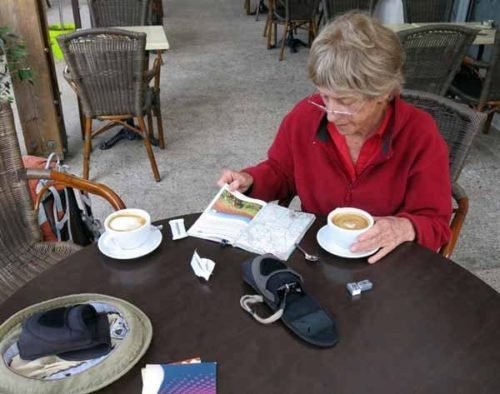
Tuesday, 2 July 2013
Distance 21 km
Duration 4 hours 40 minutes
Ascent 138 m, descent 158 m
Map 171 of the TOP100 lime-green series
Topoguide (Ref 7000) Le chemin de Régordane
Whilst paying the bill for dinner last night, we had asked what time the bar opened in the morning, and the good news was that it opened at 7.
Knowing it was not a long walk to St-Gilles, we timed our muesli consumption (sitting on a big boulder beside our tent) so that we could pack up and arrive as the doors opened, but when we got there the place was in full swing, with several drinkers already leaning comfortably on the counter. We had our coffee outside in the beautiful pearly morning light, at a table on the deserted terrace, and finally got going at about 7:30.

Back on the road, we continued where we had left off yesterday, but with twice the enthusiasm, thanks to the reviving effect of the sleep and the coffee.
It was only a few hundred metres to a large roundabout where the highway veered to the right, but the GR took the small road straight ahead, with vines on either side.
We had entered the exclusive wine-growing area known as Costières de Nîmes, which contained some of the oldest vineyards in Europe, going back to Roman times.

At an intersection of tiny roads, we left the bitumen and took a red dirt track up past some vines and into a mass of apple orchards, where the trees, espaliered in rows onto stout trellises and separated by strips of lawn, hung heavy with green fruit.
A couple of athletic looking men sprinted towards us and passed by with a wave.
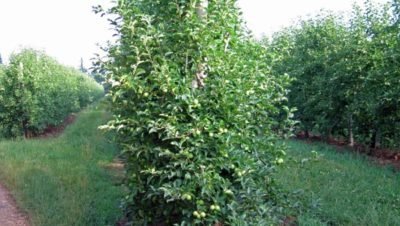
A bit further on we encountered more runners in several waves, not quite as impressive, and after we had skirted the handsome château of la Tuilerie, with its huge wine-making sheds, we met the unfit end of the race, the ones who were reduced to a shuffle.

The track turned right and the apple orchards gave way to apricots. We had never seen such magnificent crops, the fruit huge and almost scarlet. Naturally we removed a few choice specimens to eat as we went along.
Walking through this garden of plenty was quite a contrast with the cold, austere mountain scenery of the first part of the Régordane.
After a while we came to a farmhouse and a little bitumen road, which led us directly into the village of Générac, while planes taking off from the nearby airport of Nîmes thundered low over our heads. Coming into the town on a descending road, it did not look very promising but we found a boulangerie and then a bar, the two things that we most wanted to see.
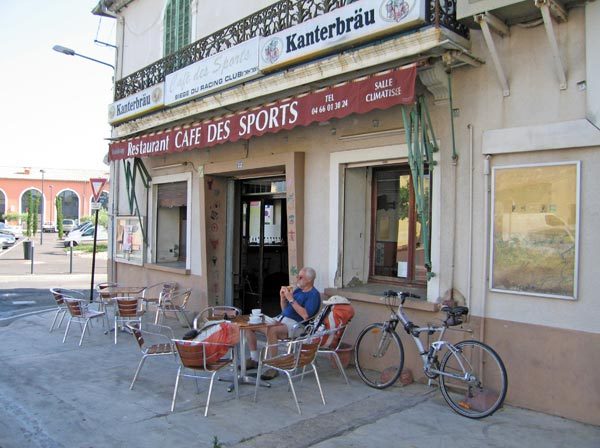
Before long we were comfortably installed outside a slightly run-down bar with our second breakfast laid out in front of us.
We still felt quite fresh as we had only been walking for two hours and it had been a gardener’s paradise the whole way.
We set off again at about 10 am, went around the corner and found ourselves in a very pretty tree-shaded church square, obviously the centre of town, with two or three pleasant looking bars.
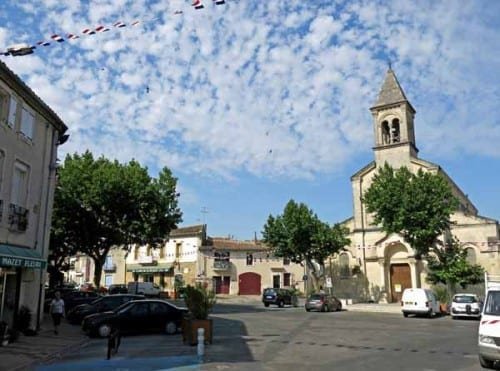
We had stopped too soon, not that it mattered greatly (we had made the same mistake the week before, in Costaros, when we over-cautiously stopped at the first bar that we came to).
Up the road from the square was a monstrous round tower, blackened with age – the remains of the local château – and beyond that we crossed the highway and thrashed about a bit before reaching the small road that we needed.
However, the GR signs were good and we never got lost.
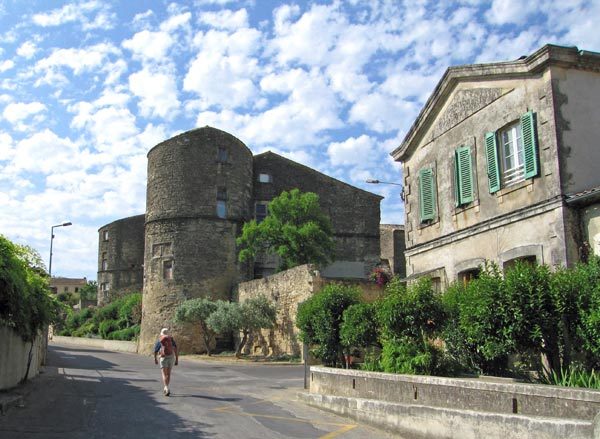
We walked along this road for half an hour, through orchards and fields of wheat, where a surprising number of people were at work.
A tractor laden to overflowing with glorious apricots lurched onto the road, accompanied by several men, and a large harvester was crawling through a hayfield converting the cut grass into bales, which toppled off the back one by one.
At a crossroads we turned off onto a wide dirt track heading south. The whole landscape was given over to vines, broken only by the occasional olive plantation.


We saw a thin tractor threading between the rows of vines, carrying aloft a mass of snake-like hoses which were spraying some vile, sweet-smelling poison onto the leaves as we hurried past, holding our breath.
We had to detour slightly to get over a small stream and after that the land became flatter. Instead of vines there were orchards – cherries, peaches and apricots, but only the apricots were ripe. There was also a rose farm and an enormous series of greenhouses.

Just as we finished stuffing the tops of our packs with apricots, which we intended to eat for the next few breakfasts, a farm truck cruised up behind us and stopped. In it we recognised the wizened farmer who had been inspecting his irrigation system further back.
He leaned out of the window and we waited, with guilt written all over our faces, to be accused of theft. His first remark was a blunt “I own all these apricots!”. His second was “Take as many as you like – just make sure you get the best ones!”. We were so astonished and relieved that we shook his hand fervently before he drove on.
We had run out of water by this time so we got through a lot of juicy apricots before we arrived at the canal at the northern edge of St-Gilles (the Bas-Rhône-Languedoc canal).
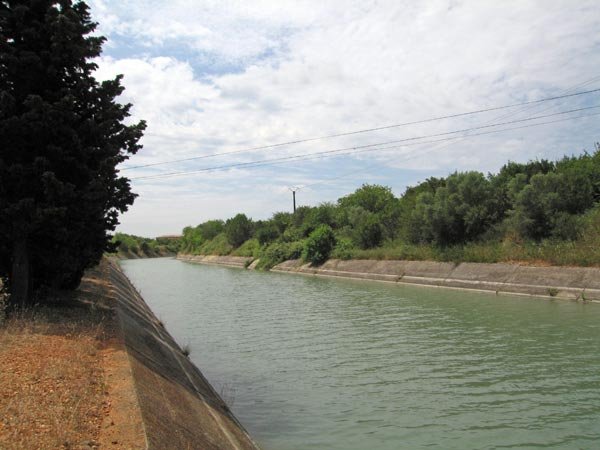
After crossing this and the highway bypass, we still had a rather long, tedious walk, up and down some steep streets, before we got to the commercial centre, which we remembered from previous visits. Then it was further than we expected to the big camping banner strung across the main street, but from there it was only a few steps to the camping ground itself.
Everything was the same as last year in the camping ground, except that the mosquitoes were not such a nuisance. There are very few places in France where we have had trouble with biting insects, but St-Gilles, surrounded as it is by swamps, rivers and canals, is one of them. We took the precaution of pitching our tent on an open piece of grass instead of under the vine-covered niche that we had chosen last year, and the mosquitoes left us alone.

Once again we were not tempted by lunch. What we needed was water, both internally and externally. Fortunately, the showers were hot and strong and afterwards we felt wonderfully fresh in our clean clothes, lying on our mats gazing up into the sky, which was full of criss-crossing swallows.
In due course we felt capable of a little light tourism, so we strolled to the abbey, which was, after all, traditionally the goal of the whole pilgrimage. On the way we stopped at the Office of Tourism, which was in the main street close to the abbey, and got the timetable for our bus ride to Nîmes.
The abbey was up a couple of crooked lanes, in a square. It stood at the top of a flight of wide, shallow stairs, with its three arched portals bathed in afternoon sunlight.
The original abbey was founded by the hermit saint in the seventh century, but the present building mostly dates from the seventeenth, after the older church was destroyed in the war against the Protestants.
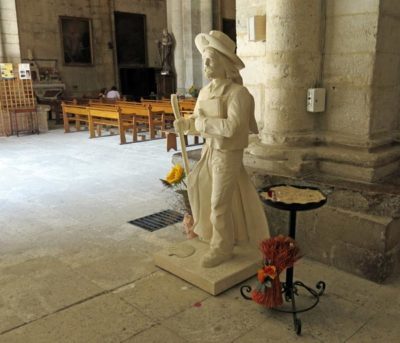
We went inside and were greeted by a bright new statue of a man in shirt and trousers, unconvincingly adorned with the pilgrim attributes of stick, cockle-shell and cape.
Averting our gaze from this unfortunate sight, we admired the simple beauty of the rest of the church, and were about to go down to the crypt when the guardian switched off all the lights and ushered us out through a side door, as it was closing time.

In search of an apéritif, we wandered back through narrow lanes, down to the main street and found a shady terrace at the Café de la Poste. Here we spent a happy hour or so, watching the good citizens of St-Gilles go about their business.
There were many restaurants in the town, but we remembered the lovely evening that we had had last year at the boat harbour (on the Rhône-Sète canal), so we went back there.
Apart from the food, there was the pleasant nautical atmosphere, with boats moored all along the water’s edge. The place where we had eaten last year (Clément IV) did not have a menu that we liked, so we tried the one on the corner that had been closed then, Tony’s Pizzeria.
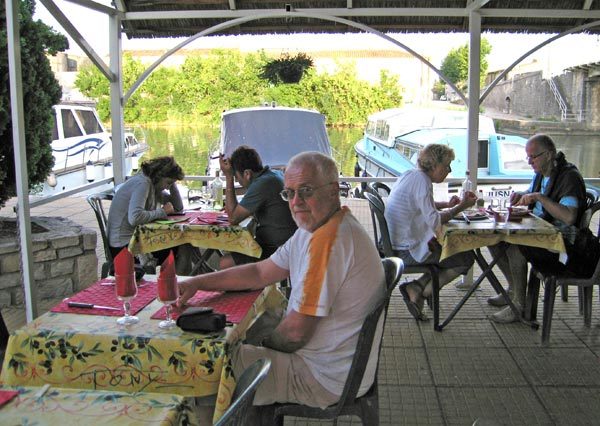
Like many pizzerias in France, Tony’s served a full range of dishes as well as pizzas and pasta. The menu was expensive by our standards – €22 – but we decided to get one menu plus an extra main dish.
We sat down amongst a crowd of diners, at first not on the picturesque edge nearest the water. A young couple were occupying the table that we wanted, and they never looked up from their mobile phones the whole time they were there. Nor did they say a word to each other. Their food arrived and was ignored as they tapped away assiduously.
When some other people left, I asked the waitress, and she hastily cleared the table to allow us to move across to the water’s edge.
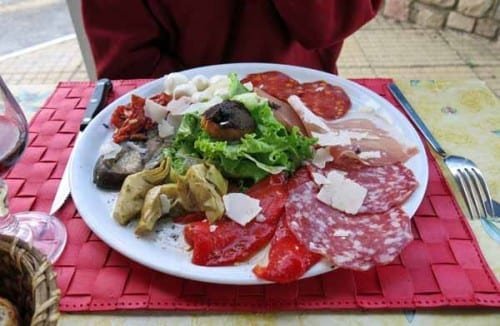
We began with an antipasto platter, a mountain of colourful treats – salami, ham, parmesan cheese, artichokes, roasted vegetables, bocconcini, salad and olive tapenade. We fell on this with gusto and finished a basket of bread with it.
The main courses were steak and lasagne, both monumental in size and beautifully cooked. We did our best but could not finish either of them, so the rest went into the plastic bags that I always carry for such moments, and made a splendid lunch the following day.
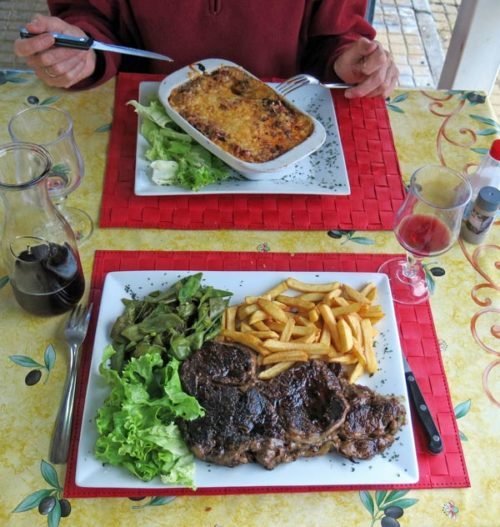
There was still dessert and a cheese course to come. Keith had two scoops of ice-cream (rum-and-raisin/coffee), but the cheese all disappeared into my bag for another day.
Meanwhile we noticed that the young phone-obsessed couple were leaving. They paid the bill, exchanged a long, passionate kiss, and walked off in opposite directions. Their version of a romantic evening, we supposed.
It was getting dark before we left and when we got back to the camping ground, the gate was locked, but we had been given the code to open it when we paid.
We lay down in our little tent, well satisfied with our last day on the Régordane, and looking forward to a couple of days of leisure with our friends in Montpellier.
Leaving Saint-Gilles
There is a frequent bus service to Nîmes railway station. From there you can go to almost anywhere in France.
Previous day: St-Geniès-de-Malgoirès to Nîmes
Back to this section’s summary